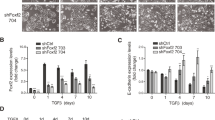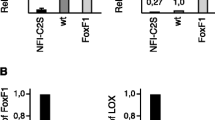Abstract
Epithelial–mesenchymal transition (EMT) promotes tumor invasion and metastasis, but the coordination and integration mechanisms of these processes are still not fully understood. In this study, we used a cross-species expression profiling strategy of Hela cells to determine an important genetic program transfers. In particular, we have discovered a new transfer function, which is not previously known about transcription factor forkhead box Q1 (FOXQ1). The shRNA anti-FOXQ1 gene was synthesized and transfected into the Hela and EpRas cells. RT-PCR assay was performed to detect the mRNA levels in cells. Cell adhesion and separation assay were used to examine the cell–cell adhesion and separation among cells. Wound healing assay was utilized to examine cell migration and invasion ability. Chromatin immunoprecipitation assay was used to investigate the interaction between E-cadherin and N-cadherin and FOXQ1 promoter region. The results indicated that ectopic expression of FOXQ1 increased cell migration and invasion in vitro, enhanced mammary epithelial cells in vivo lung metastasis, and triggered significant EMT. In contrast, the opposite effects in vitro and in vivo of FOXQ1 knockdown phenotypes were caused by these mechanisms. Notably, FOXQ1 repressed core EMT regulation of the expression of TGF-β1. FOXQ1 protein directly interacts with E-cadherin and N-cadherin promoter region. And surveys show that FOXQ1 expression regulation by TGF-β1 and blockade induced EMT both morphological and molecular levels. Our findings emphasize the feasibility of cross-species expression profiles, as a strategy to identify metastasis-related genes. The induction of EMT by FOXQ1 defines a new transfer function in promoting cancer behind possible mechanisms.





Similar content being viewed by others
Change history
26 April 2024
This article has been retracted. Please see the Retraction Notice for more detail: https://doi.org/10.1007/s11010-024-05018-9
References
Li J, Song Y, Wang Y, Luo J, Yu W (2013) MicroRNA-148a suppresses epithelial-to-mesenchymal transition by targeting ROCK1 in non-small cell lung cancer cells. Mol Cell Biochem 380:277–282
Zhu Z, Zhu Z, Pang Z, Xing Y, Wan F, Lan D, Wang H (2013) Short hairpin RNA targeting FOXQ1 inhibits invasion and metastasis via the reversal of epithelial–mesenchymal transition in cancer. Int J Oncol 42:1271–1278
Zhang H, Meng F, Wu S, Kreike B, Sethi S, Chen W, Miller FR, Wu G (2011) Engagement of I-branching β-1, 6-N-acetylglucosaminyltransferase 2 in breast cancer metastasis and TGF-β signaling. Cancer Res 71:4846–4856
Feuerborn A, Srivastava PK, Kuffer S, Grandy WA, Sijmonsma TP, Gretz N, Brors B, Grone HJ (2011) The forkhead factor FOXQ1 influences epithelial differentiation. J Cell Physiol 226:710–719
Wu CW, Storey KB (2014) FoxO3a-mediated activation of stress responsive genes during early torpor in a mammalian hibernator. Mol Cell Biochem 390:185–195
Drasin DJ, Robin TP, Ford HL (2011) Breast cancer epithelial-to-mesenchymal transition: examining the functional consequences of plasticity. Breast Cancer Res 13:226
Dooley S, Hamzavi J, Ciuclan L, Godoy P, Ilkavets I, Ehnert S, Ueberham E, Gebhardt R, Kanzler S, Geier A, Breitkopf K, Weng H, Mertens PR (2008) Hepatocyte-sspecific Smad7 expression attenuates TGF-β–mediated fibrogenesis and protects against liver damage. Gastroenterology 135:642–659
Qin Y, Capadlo C, Gumbiner BM, Macara IG (2005) The mammalian scribble polarity protein regulates epithelial cell adhesion and migration through E-cadherin. J Cell Biol 171:1061–1071
Hackett NR, Shaykhiev R, Walters MS, Wang R, Zwick PK, Ferris B, Witover B, Salit J, Crystal RG (2011) The human airway epithelial basal cell transcriptome. PLoS ONE 6:e18378
Voutsadakis IA (2012) The ubiquitin-proteasome system and signal transduction pathways regulating epithelial mesenchymal transition of cancer. J Biomed Sci 19:67
Lama V (2014) Biomarkers for lung disease monitoring. US Patent No. 8,637,232
Xiong H, Hong J, Du W, Lin YW, Ren LL, Wang YC, Su WY, Wang JL, Cui Y, Wang ZH, Fang JY (2012) Roles of STAT3 and ZEB1 proteins in E-cadherin down-regulation and human colorectal cancer epithelial–mesenchymal transition. J Biol Chem 287:5819–5832
Wang Q, Wang Y, Zhang Y, Zhang Y, Xiao W (2013) The role of uPAR in epithelial–mesenchymal transition in small airway epithelium of patients with chronic obstructive pulmonary disease. Respir Res 14:67
Giannoni E, Parri M, Chiarugi P (2012) EMT and oxidative stress: a bidirectional interplay affecting tumor malignancy. Antioxid Redox Signal 16:1248–1263
Kaneda H, Arao T, Matsumoto K, de Velasco MA, Tamura D, Aomatsu K, Kudo K, Sakai K, Nagai T, Fujta Y, Tnaka K, Yanagihara K, Yamada Y, Okamoto I, Nakagawa K, Nishio K (2011) Activin A inhibits vascular endothelial cell growth and suppresses tumour angiogenesis in gastric cancer. Br J Cancer 105:1210–1217
Zhang J, Yang Z, Li P, Bledsoe G, Chao L, Chao J (2013) Kallistatin antagonizes Wnt/beta-catenin signaling and cancer cell motility via binding to low-density lipoprotein receptor-related protein 6. Mol Cell Biochem 397:295–301
Sehrawat A, Singh SV (2011) Benzyl isothiocyanate inhibits epithelial–mesenchymal transition in cultured and xenografted human breast cancer cells. Cancer Prev Res 4:1107–1117
Guan X, Bartlett JD (2013) MMP20 modulates cadherin expression in ameloblasts as enamel develops. J Dent Res 92:1123–1128
Zhang H, Meng F, Liu G, Zhang B, Zhu J, Wu F, Ethier SP, Miller F, Wu G (2011) Forkhead transcription factor FOXQ1 promotes epithelial–mesenchymal transition and breast cancer metastasis. Cancer Res 71:1292–1301
Qiao Y, Jiang X, Lee ST, Karuturi RK, Hooi SC, Yu Q (2011) FOXQ1 regulates epithelial–mesenchymal transition in human cancers. Cancer Res 71:3076–3086
Acknowledgments
The present study was financially granted by the projects of Henan education bureau (ID. 13A310230).
Conflicts of interest
The authors declare that there are no conflicts of interest.
Author information
Authors and Affiliations
Corresponding author
Additional information
This article has been retracted. Please see the retraction notice for more detail: https://doi.org/10.1007/s11010-024-05018-9
About this article
Cite this article
Fan, DM., Feng, XS., Qi, PW. et al. RETRACTED ARTICLE: Forkhead factor FOXQ1 promotes TGF-β1 expression and induces epithelial–mesenchymal transition. Mol Cell Biochem 397, 179–186 (2014). https://doi.org/10.1007/s11010-014-2185-1
Received:
Accepted:
Published:
Issue Date:
DOI: https://doi.org/10.1007/s11010-014-2185-1




